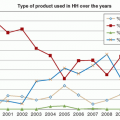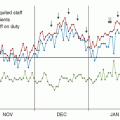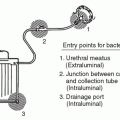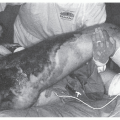Disease/Problem |
Work Restriction |
Duration |
Conjunctivitis |
Restrict from patient contact and contact with the patient’s environment |
Until discharge ceases |
Cytomegalovirus infections |
No restriction |
Diarrheal diseases |
|
Acute stage (diarrhea with other symptoms) |
Restrict from patient contact, contact with the patient’s environment, or food handling |
Until at least 48 hours after resolution of symptoms consistent with norovirus infection |
|
Convalescent stage, Salmonella spp. |
Restrict from care of high-risk patients |
Until symptoms resolve; consult with local and state health authorities regarding need for negative stool cultures |
Group A streptococcal infections |
Restrict from patient care, contact with the patients environment, or food handling |
Until 24 hours after adequate treatment started |
Hepatitis A |
Restrict from patient contact, contact with patient’s environment, and food handling |
Until 7 days after onset of jaundice |
Herpes simplex hands (herpetic whitlow) |
Restrict from patient contact and contact with the patient’s environment |
Until lesions have crusted |
Measles active |
Exclude from duty |
Until 4 days after the rash appears |
|
Postexposure (HCP without evidence of immunity) |
Exclude from duty |
From the 5th day after the 1st exposure through the 21st day after last exposure |
Meningococcal infections |
Exclude from duty |
Until 24 hours after start of effective therapy |
Mumps active |
Exclude from duty |
Until 5 days after onset of parotitis |
|
Postexposure (HCP without evidence of immunity) |
Exclude from duty |
From 12th day after 1st exposure through until 25 days after last exposure or until 5 days after onset of parotitis |
Pertussis active |
Exclude from duty |
From beginning of catarrhal stage through 3rd week after onset of paroxysms or until 5 days after start of effective antimicrobial therapy |
|
Postexposure (asymptomatic personnel-HCP likely to expose a patient at risk for severe pertussis) |
No restriction from duty; on antimicrobial prophylactic therapy |
|
Postexposure (asymptomatic personnel-other HCP) |
No restriction, can receive PEP or be monitored for 21 days after exposure |
|
Postexposure (symptomatic personnel) |
Exclude from duty |
Until 5 days after start of effective antimicrobial therapy |
Rubella Active |
Exclude from duty |
Until 7 days after rash appears |
Postexposure (HCP without evidence of immunity) |
Exclude from duty |
From 7th day after 1st exposure through 23rd day after last exposure |
Staphylococcus aureus infection |
|
Acute, active, draining skin lesions |
Restrict from contact with patients and patient’s environment or food handling |
Until lesions have resolved |
|
Chronic, draining skin lesions |
Restrict from contact with patients and patient’s environment or food handling |
Until lesions have resolved, though considerations for earlier return to work could include the location of the provider’s infection, if the lesion can be completely covered, the hand hygiene and infection prevention practices of the individual provider, and others. |
Tuberculosis |
|
Active disease |
Exclude from duty |
Until proved noninfectious |
|
TST or IGRA converter |
No restriction |
Varicella active |
Exclude from duty |
Until all lesions dry and crust. If only lesions that do not crust (i.e., macules or papules), until no new lesions appear within a 24-hour period. |
|
Postexposure (HCP without evidence of immunity) |
Exclude from duty until receipt of the second dose of varicella vaccine within 3-5 days of exposure |
From 8th day after 1st exposure through 21st day (28th day if VariZIG given) after last exposure; if varicella occurs, until all lesions dry and crust or, if only lesions that do not crust (i.e., macules or papules), until no new lesions appear within a 24-hour period |
Viral respiratory infections, acute febrile |
Exclude from duty |
Until afebrile for greater than 24 hours (without the use of fever-reducing medications, such as acetaminophen) |
|
|
|
Consider for temporary reassignment or exclusion from work for 7 days from symptom onset or until the resolution of symptoms, whichever is longer, if returning to care for patients in a protective environment, such as hematopoetic stem cell transplant patients. |
Zoster |
|
Localized, in immunocompetent HCP |
Cover lesions; restrict from care of high-risk patients (pregnant women, neonates, and immunocompromised patients of any age) |
Until all lesions dry and crust |
|
Disseminated or localized in immunosuppressed HCP |
Exclude from duty |
Until all lesions dry and crust |
|
Postexposure (HCP without evidence of immunity-dissem inated zoster or localized zoster with uncontained/uncovered lesions) |
Exclude from duty unless receipt of the second dose of varicella vaccine within 3-5 days after exposure |
From 8th day after 1st exposure through 21st day (28th day if VariZIG given) after last exposure or, if varicella occurs, until all lesions dry and crust or if only lesions that do not crust (i.e., macules and papules), until no new lesions appear within a 24-hour period |
|
Postexposure (HCP without evidence of immunity-localized zoster with contained/covered lesions) |
For HCP with at least one dose of varicella vaccine, no work restrictions. For HCP with no doses of varicella vaccine, restrict from patient contact |
From 8th day after 1st exposure through 21st day (28th day if VariZIG given) after last exposure or, if varicella occurs, until all lesions dry and crust or if only lesions that do not crust (i.e., macules and papules), until no new lesions appear within a 24-hour period |
Modified from Bolyard EA, Tablan OC, Williams WW, et al. Guideline for infection control in healthcare personnel, 1998. Infect Control Hosp Epidemiol. 1998;19:407-463. |









